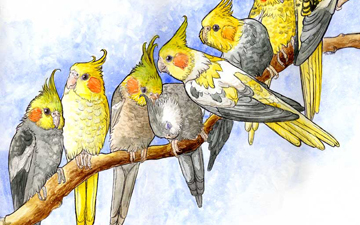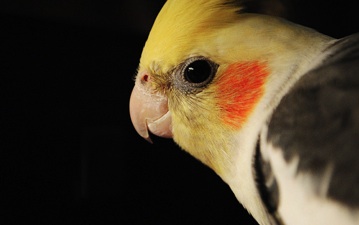The Cockatiel (Nymphicus hollandicus), also known as the Quarrion and the Weiro, is the smallest cockatoo endemic to Australia. They are prized as a household pet and companion parrot throughout the world and are relatively easy to breed. As a caged bird, cockatiels are second in popularity only to the Budgerigar.[2]
Cockatiels are native to Australia, where they are found largely in arid or semi-arid country, but always close to water. Largely nomadic, the species will move to where food and water is available.[2] They are typically seen in pairs or small flocks.[2] Sometimes, hundreds will flock around a single such body of water. To many farmers’ dismay, they often eat cultivated crops. They are absent from the most fertile southwest and southeast corners of the country, the deepest Western Australian deserts, and Cape York Peninsula. They are the only Cockatoo species which can sometimes reproduce in the end of their first year.
The Cockatiel’s lifespan in captivity is generally given as 15–20 years,[6] though it is sometimes given as short as 10–15 years, and there are reports of Cockatiels living as long as 32 years, the oldest confirmed specimen reported being 36 years old.[7] Diet and exercise are major determining factors in cockatiel lifespan.
(From Wikipedia, 28 February 2012)
—
Cockatiels are mainly grey with paler underparts that are sometimes washed with brown. There is a prominent patch of orange on the ear coverts, and the rest of the head and crest are yellow. The underside of the tail is black in the male and yellow in the female. Several plumage variants of the species are recognized. The Lutino mutation (Albino or White) is the most popular. These attractive birds are white with white or pale yellow underparts. The yellow face and crest are retained.
In the wild, the Cockatiel feeds on the seeds of grasses and herbacious plants, grains, fruits, and berries. They prefer, however, Acacia seeds. They are also known to raid standing fields of crops such as sorghum.
The breeding season seems to depend on climatic conditions, especially in rainfall. The species usually begins breeding after the rainy season. Nesting starts in August and continues through December. Nests are usually located in a hole of a eucalypt tree that is standing near water. Clutch size ranges from four to six rounded eggs. Incubation lasts 18 to 20 days. The Cockatiel is one of the few species of parrots that share brooding duties between the male and the female. During the day, the male incubates the eggs; the female takes over brooding duties at night. Both parents feed the chicks from the time they are hatched. After four to five weeks, the chicks leave the nest.
The pair bond between two birds can be quite strong and they may remain partners for life. The Cockatiel is often observed in pairs or small flocks. In the north, the species is highly nomadic, but southern populations are more migratory. In flight, they they are swift and direct.
(From EOL, 28 February 2012)





